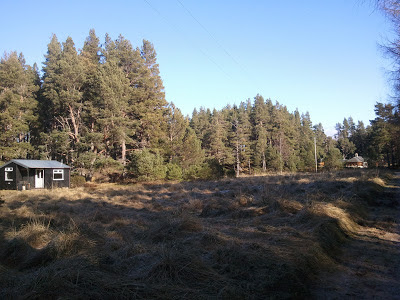Enjoyed a great day in Speyside thanks to the Citylink "go anywhere in Scotland for £2" deal. The journey by road isn't quite as good as that by train, in that there is more disturbance along the A9 than the railway. However sightings included ten Oystercathers and 20 Greylag Geese at Blair Atholl, two Red Grouse at Drumochter and 30 Greylag Geese near Lynchat. Thirty unidentified ducks at Spey bridge were probably Teal.
 |
| A sunny morning in Aviemore... |
Arrived in Aviemore at 11am to find blue skies and strong sunshine (although the temperature was below zero and stayed that way all day). A short bus trip later (single Buzzard at Laggantygown) I was at Nethybridge and the start of the walk. A good look around the centre of Nethybridge failed to locate the usual Dipper(s) on the river. However other birds in the area included Treecreeper, Rook and Pheasant, along with singing Greenfinch (the first of many today), Chaffinch and Collared Dove.
 |
| ...and in Nethybridge |
Heading up-river, plenty of small birds were on the feeders in the gardens on either bank. Thought I heard a Crested Tit call, but had to be content with Coal Tit, Great Tit, Long-tailed Tit and Siskin. A Red Squirrel was further along the path.
Arriving at the Dell of Abernethy, I was reminded of the story of the two weavers who perished one New Years day after setting out from there for Braemar. Near there were Rook, Jackdaw and Siskin. The path then entered Dell Woods and continued through the RSPB Abernethy Reserve. The pine woods were beautiful in the winter sunshine but try as I might, I couldn't locate any birds apart from the ubiquitous Coal Tit.
The first exception to that rule finally arrived on joining the Forest Lodge road near Cuchanlupe where a Treecreeper was with at least five Coal Tits. The forest lochans near there were frozen solid.
 |
| Buildings at Cuchanlupe |
Took the path over to Straanruie where the diversity of bird life started to increase as soon as the cottages came into view. Greenfinch, Goldfinch, Chaffinch and House Sparrow were all present here and in Tulloch. Twenty-seven Mallards and two Jackdaws were at Loch Tulloch.
Decided to take the Tulloch Moor road rather than go round by Loch Garten. Bird life was scarce away from the cottages at the east end. However two Bullfinches were quietly feeding on Heather tips and a male Reed Bunting was equally quiet as it slipped away through a patch of scrub.
A little further on, two Ravens flew overhead. I heard them coming well before they appeared, one giving a repeated high-pitched call while the second replied with the usual low croak. They appeared over the trees in the west and continued in the direction of Loch Garten. I would guess they flew over the spot where a group of RSPB staff were burning patches of the moor.
Avoided a bit of the road at Glencairn by cutting through the forest in the direction of Auchgourish Arboretum. Again there was very little about except for Coal Tits and a single Roe Deer.
The walk back along the road to Boat of Garten produced some nice sightings including the usual range of garden species in Street of Kincardine, a Woodpigeon and a Mistle Thrush at Mullingarroch, and two Song Thrushes plus a Mistle Thrush in a field at Gartenmore.
Arriving at Garten Bridge, a pair of Goldeneye were on the Spey, with the snow-covered Cairngorms as the backdrop. Milton Loch was frozen and devoid of any waterfowl. However two Herring Gulls were a surprise as they flew over, Rooks and Jackdaws were going to roost and a Grey Heron arrived noisily at its nest to be greeted, equally noisily, by its mate. Sixty Jackdaws were over Boat of Garten and one was seen to enter the chimney pot of the post office.

Back in Aviemore, six Mallards and a Carrion Crow were near the Leisure Park.
The total bird count for today was 30 species: Mallard, Goldeneye, Pheasant, Grey Heron, Buzzard, Herring Gull, Woodpigeon, Collared Dove, Jackdaw, Rook, Carrion Crow, Raven, Blue Tit, Great Tit, Coal Tit, Long-tailed Tit, Treecreeper, Wren, Blackbird, Song Thrush, Mistle Thrush, Robin, Dunnock, House Sparrow, Chaffinch, Greenfinch, Goldfinch, Siskin, Bullfinch and Reed Bunting. No Speyside "specialities", and nothing particularly dramatic, but some good birds in beautiful surroundings.
Impressions of Strathspey in February:
Its cold - the temperature didn't rise above zero degrees all day
The woods are quiet - with Coal Tit being all I could find in many areas
Birds remain concentrated around the towns and villages
There is no sign yet (that I could see) of any new plant growth
The predominant colour in the landscape is yellow - the colour of dry grass.



0 Comments:
Post a Comment
<< Home